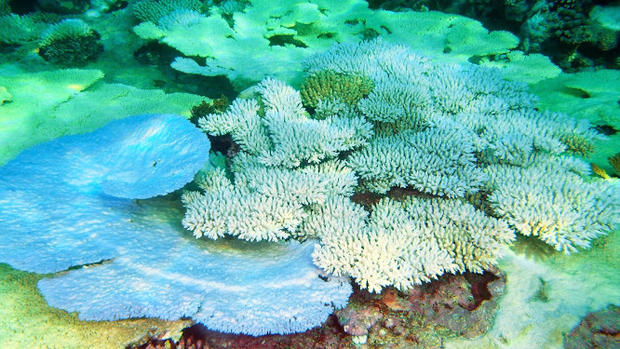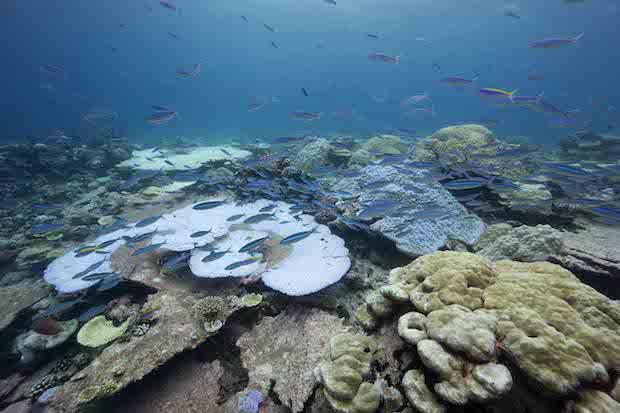Indian Ocean reefs hit by coral bleaching
Coral bleaching has reached the Indian Ocean after ravaging reefs in the Pacific, raising the prospect that damage from warming seas and other stressors could soon be seen on a global scale.
Scientists surveying reefs last month in the remote British Indian Ocean Territory (BIOT), located about 600 miles south of the Maldives, recorded the telltale signs of trouble - stark white reefs and others with faded blues and pinks.
"At first, I was really quite alarmed," said Andrew Bruckner, the chief scientist for the Khaled bin Sultan Living Oceans Foundation, whose group undertook two separate surveys on the reefs as part of its Global Reef Expedition. They observed no bleaching on the first survey, in March, but did in the second, which took place in April and early May.
"From no bleaching, we saw something occur quite quickly which I never expected to happen that fast," he told CBS News. "Toward the end of our mission, we started to see mortality. If we lose all the corals in that area, this would be quite significant."
The findings, provided exclusively to CBS News, are the first reports of a bleaching event in the Indian Ocean this year.
They follow warnings in February from the National Oceanic and Atmospheric Administration that warm waters in the tropical Pacific and Indian Oceans could spark widespread coral bleaching across the world this year. It would be the third global bleaching event; the first two took place in 1998 and 2010.
"You are going from something that was a Pacific Ocean bleaching event to one that is headed towards being a global event," Mark Eakin, coordinator of NOAA's Coral Reef Watch, told CBS News. "Every time we had one of these global events, they started in the Pacific, then you had outbreaks in the Indian Ocean and then later a third basin in the Atlantic including the Caribbean. That is what we are on the look out for."
Reefs are one of the world's most important ecosystems, supporting more species than any other marine environment, including 4,000 fish species. They are also a crucial to sustaining many coastal communities that thrive on the $375 billion a year reaped through diving, fishing and tourism.
Bleaching is akin to coral cancer. It occurs when corals are stressed by changes in conditions such as temperature, light or nutrients. They respond by expelling the symbiotic algae living in their tissues, causing them to turn white. Without the algae, the coral loses its major source of food and starves to death.
In some of the 100 sites surveyed, Bruckner said his team found evidence that increased temperatures and light could have played a role in the bleaching.
They recorded temperatures that were nearly seven degrees Fahrenheit above normal, and signs that light was reaching much deeper to the reefs and "was more intense," due to the calm and clear waters.
"We have the combination of some temperature stress but the light, when you have this temperature stress, was really overwhelming these corals," Bruckner said.
"The symbiotic algae that live in the tissue are photosynthesizing - just like a plant does on land," he said. "If there is too much light, their photo systems break down and they produce these oxygen compounds that cause stress to the coral animal."
Bruckner surmised that the weather phenomena known as El Nino - created when the equatorial waters of the Pacific Ocean warm significantly - could also be playing a part.
Earlier this month, NOAA concluded that there was a 90 percent chance that El Nino conditions will continue in the Northern Hemisphere through the summer and a greater than 80 percent chance that it will last through 2015. The last time the world saw a strong El Nino was in 1998, the year of one of the worst global bleaching events.
"I do think it has played role," he said of El Nino. "The temperature increased higher than normal so that has to be associated with a climatic event. When there are El Nino events, you tend to see different wind patterns. You tend to see the breakdown of this upwelling (cold water coming from deeper in the ocean) and we didn't see the typical upwelling you would see."
While the bleaching in BIOT was troubling, Bruckner said the isolated location as well as recent research that found these corals play host to higher numbers of light-resistant symbionts known as clade A could offer hope for a recovery.
Most of the reefs in the Indian Ocean, in contrast, are much more vulnerable because they already have been weakened by additional stressors such as pollution, overfishing and other human activities.
"Because it is so undisturbed and because we saw high levels of baby corals, it is very likely that, even if all those corals died, BIOT would show pretty quick recovery and those reefs in 15 years would pretty much look the same again," he said. "That is not the case for the rest of the Indian Ocean because the rest of the Indian Ocean hasn't rebounded from 1998 as BIOT has and there are a lot more human stressors."


